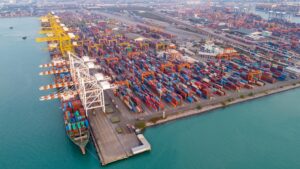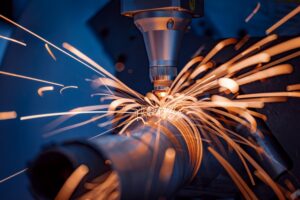3D Printing Trends 2026

3D printing isn’t standing still, and neither are we. Here are the top 3D printing trends to look out for in 2026.
3D printing isn’t standing still, and neither are we. Once a niche tool for rapid prototyping, it’s now transforming the way industries design, produce, and deliver. As we head into 2026, we’re seeing some huge leaps in automation, sustainability, and material innovation – and at 3D Print Bureau, we’ve got a front-row seat to what’s next.
Here are the top 3D printing trends to look out for in 2026.
Automation and AI take centre stage
AI and automation are changing the game for additive manufacturing. In 2026, expect to see AI-powered design software that can automatically optimise structures for strength, efficiency, and material use. Machine learning and robotics will continue to drive hyper-automated workflows, managing everything from design through to post-processing.

Predictive maintenance, powered by IoT-connected sensors, will further reduce downtime by flagging issues before they occur. This will allow businesses to create reliable components much quicker, helping them move seamlessly from prototype development to full-scale production.
Bioprinting and medical innovation
Healthcare continues to be one of the most exciting frontiers for additive manufacturing. Bioprinting, which was once confined to research labs, is now moving closer to mainstream use. In 2026, we can expect to see huge breakthroughs in tissue engineering, regenerative medicine, and custom medical devices.

From patient-specific implants and surgical guides to bespoke prosthetics, 3D printing is making medical treatments more accessible and effective. We’re also seeing the rise of remote healthcare manufacturing, where hospitals and clinics can 3D print medical tools on-site, which will help to cut delivery times and improve patient care.
Sustainable materials lead the way
Sustainability remains one of the most significant 3D printing industry trends in 2026. Additive manufacturing already helps to minimise waste by building parts layer by layer, but new materials are pushing this even further. This year, we can expect continued growth in biodegradable, bio-based, and recycled filaments, along with durable high-performance composites designed for extreme applications.

This move towards circular manufacturing (where materials are reused, recycled, and repurposed) is helping businesses to significantly reduce emissions and rethink traditional production methods for a cleaner, more responsible future.
On-demand and localised manufacturing
Flexibility has become a cornerstone of modern 3D printing. On-demand production allows businesses to manufacture exactly what they need, when they need it, eliminating unnecessary inventory and storage costs.

Localised 3D printing is also reshaping supply chains. By producing parts closer to the point of use, manufacturers can respond faster to demand, cut logistics costs, and reduce their carbon footprint. Plus, with the rise of 3D Printing as a Service (3DPaaS), businesses can access industrial-grade additive technology without heavy investment. Simply send your design files to an expert partner like 3D Print Bureau, and we’ll take care of the rest.
Enhanced quality control and digital security
With more industries relying on additive manufacturing than ever before, the need for robust quality control and secure data management has never been higher. AI-driven inspection tools are now capable of analysing every layer during printing to ensure dimensional accuracy and eliminate waste.

Meanwhile, encrypted file transfers and digital tracking systems are protecting intellectual property and preventing data tampering, which is critical for sectors such as aerospace, automotive, and medical.
Hybrid manufacturing and multi-material printing
The line between additive and traditional manufacturing continues to blur. Hybrid manufacturing, i.e. combining 3D printing with CNC machining or milling, allows manufacturers to achieve tighter tolerances, smoother finishes, and faster production times than ever before in 2026.

At the same time, multi-material 3D printing is becoming increasingly sophisticated. Printers are now capable of combining metals, polymers, and ceramics within a single build, opening the door to lightweight, high-performance parts with fewer assembly steps and greater design freedom.
Helping you stay ahead of future trends in 3D printing
The 3D printing landscape is changing fast, and the opportunities for innovation are bigger than ever. At 3D Print Bureau, we help businesses embrace the latest additive technologies with confidence. Whether you’re exploring new materials, scaling up production, or looking to future‑proof your supply chain, we’re here to help you make it happen.
Contact us for your free quote and see how we can help you bring tomorrow’s manufacturing trends to life today.

